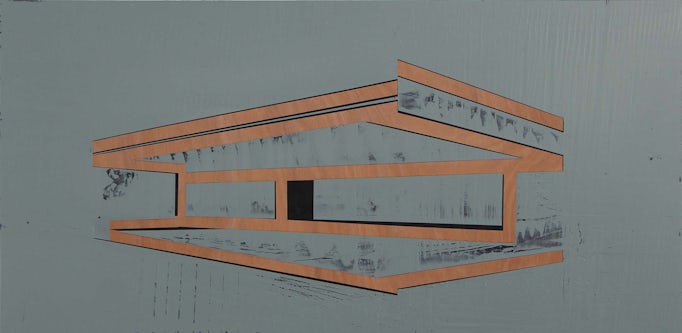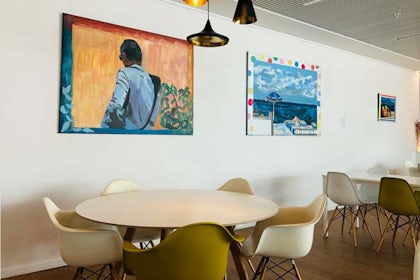Interview with Brantt
Brantt is an artist who has been in Bernice’s collection since the very beginning. He took a preliminary course in Architectural Design at Kunsthumaniora Sint-Lucas and then graduated from LUCA Ghent as Master in Graphic Design and Master in Painting. His canvases bear the influences of both his Graphic and Architectural training. He is an example of an artist who does not like to be stuck in one particular direction. He likes to broaden his horizons and is not afraid to step out of his comfort zone.

When and why did you start creating art?
During my training in Graphic Design I already made a side jump to painting in an elective studio and there I always felt a certain freedom that gave me a lot of satisfaction. After this training, I temporarily worked in the graphics sector, but after a year, in 2001, I became a student again and I started a training as a painter. After that, it was mainly a matter of switching between various advertising agencies and my studio, but now I have been a full-time independent artist for quite some time.
What kind of artist are you?
I am mainly involved in painting, although I do have a past in the world of architecture. You can see many influences from this architectural training in my paintings. Sometimes I have transformed the paintings into more spatial work, which resulted in a series of sculptures. But if you see the sculptures next to my paintings, there is a clear difference. My previous training in architecture has always been an important factor, although there is a graphic influence present in the use of colour and in the composition of my work. Actually, I have enjoyed all art directions. I don’t want to be pushed into a particular corner, which is why I have so many different styles. I always work according to a theme and every two or three years this can change. Either it’s colourful and scenic, sometimes it’s just buildings. At the moment I am working on a series of roads and bridges and my use of colour is much more sober. I used to use thick layers of paint, now it is softer.
Where do you get your inspiration from and who is your favourite artist?
I get my inspiration mainly from my surroundings. A certain exhibition location can be inspiring, for example, or working with different materials, supports, etc. Daring to take a different approach can create a lot of new ideas. Many of these things influence my work.
I don’t really have one specific artist who inspires me, but as a student, I felt a connection with some of the works of French artist Nicolas De Staël, but the work of Gordan Matta-Clark can also fascinate me.
How do you motivate yourself to start from a blank canvas?
I work in themes. When I enter my studio in the morning I immediately go for it. I then work for 3 to 5 months on the same theme. Sometimes I restart with a new theme or I expand on the previous one. Now I am again in a phase where my style will probably change. This is due to the fact that my studio has to move. A new location is a new environment, so a new perspective.
What is most important to you? Concept – process or end result?
The process is certainly important to me, but the end result is also important. My paintings are perhaps less conceptual, but they are part of a story. For example, I’m working on traffic changers now, but the content is much more than what you see. Decisions in your life, routes you take, experiences, … are all things that are decisive and determine the direction your life takes. A person is constantly on the move.
How does a work of art come about and when do you know you are ready?
I first start by taping the global lines on the canvas, which I then cut out with a knife. Cut-outs from that tape are the areas that are filled in with oil paint paste, and so this process continues to the next session. I don’t really need a pencil to sketch or a brush to paint.
It happens that I rework a work of art after years. It is only finished when I am completely satisfied with it. Some canvases are finished after a week, some works only after 3-4 years. Sometimes, after a while, you find that something is still missing. It can also happen that I find a canvas too dark, for example, and then I put a new, fresh colour on it.
Have you noticed that certain types of collectors are interested in your work?
There is often a link with interior designers and architects. People who are interested in austere buildings or architecture choose my works. They especially prefer my architectural work or sculptures. I also have landscape work and that is accessible to everyone.

Do you get a living from your art alone?
I have three sources of income. On the one hand, I sell the works of art. One time you sell a lot, another time less. On the other hand, there is the rental of my works. The income from this also fluctuates, but not as abruptly as sales. In the first years, I did not rent out as much as I do now, but I have been working for more than 15 years and my oeuvre has grown. The rental of my paintings has been built up gradually and now gives me more of a foothold. Clients also become attached to a work, which often results in a sale. I also have income from freelance work as an art handler.
How did you first come into contact with an art rental?
When I was a student at LUCA Gent in 2002 and still in my first master year, two representatives of an art rental company came to look at the work of a fellow artist who was graduating there. They had to pass by my work to reach the other guy. I was not there at the time, but they contacted me through my teacher. It initially started with five works on loan, but that has now grown to 50 or even 100 works.
Was it natural for you to go into art rental?
Because I was in my early twenties and didn’t know it at all, I thought: we’ll try it and see.
It has become an important part of the circulation of my artworks. When an exhibition is over and you still have unsold works, it is better that they circulate and that companies or other people can enjoy them. I don’t like that artworks stay in my studio, not being seen and at the same time saddling me with a storage problem. So it’s a win-win situation.
What do you do with the rental fee?
I use the fee solely for my work as an artist. It gives me the opportunity to continue investing. That can go from buying quality canvas, oil paint, tools, … to renting my studio.
What would you still like to achieve in the art world?
First and foremost, I’m happy that I can do my thing, but besides my artistry, I would like to start curating several group exhibitions. In the past, I have curated exhibition projects with fellow artist Free Pectoor, which always gave me great satisfaction. In the future, I would like to collaborate with other artists and undertake various initiatives, all of which will benefit both artists and spectators.
What do you consider to be the most important qualities for an artist?
To be innovative, critical and above all persevering. If you really want to go for it, a lot of things have to give up. I gave up my job in the graphic world – and my financial security. It did not give me much satisfaction. I can hardly see myself doing a graphic design job again and I have never felt the need to do so. I like to design, but not in function of a company. Perhaps I made the mistake of not starting out as a freelance designer, but I certainly do not regret the path I have taken in the meantime.
Do you have a tip for a starting artist?
Find a studio as soon as you graduate. You are lost if you do not have a studio. The danger is to get out of a certain flow. It is also practical to have a studio outside the house, your own place where nobody is bothered by the smell of paint, your working methods, … At home, in your private environment, you have no objective sounding board. In my current studio, there are 13 artists together, so there is always someone I can ask for feedback. You know immediately whether you are doing well or not.
Also dare to come out of your cocoon, show your work to the outside world, but better one good exhibition than 10 mediocre ones.
Latest stories

Modulys wins art rental for their headquarters
Our clientsUpdatesModulys wins Art Rental by Bernice for a year. Check out the art of their choice

How to Find the Perfect Artwork in our Collection?
Our clientsFinding the right artwork can be challenging. Bernice listed some guidelines to help you make the right choice

Art rental for offices in 5 steps
LongreadOur clients5 basic steps to start renting art for your office